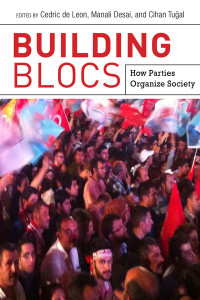Does society and its cleavages influence Parties, or rather the other way around? The book I have reviewed deals with this crucial research question in Political Sociology.
Building Blocs. How Parties Organize Society. Edited by Cedric de Leon, Manali Desai, and Cihan Tuǧal, Stanford: Stanford University Press, 2015. 242p. $24.95 cloth.
 The literature on political parties’ genesis and organization is well consolidated. Do exist brilliant books on comparative politics and in political sociology alike. On one side, the contributions of Max Weber, Stein Rokkan, Seymour Lipset and Hans Daalder have settled a clear perspective on the relevance of social cleavages and structures in shaping the born and the development of political parties, especially in western countries, and in Europe in particular. On the other side, the organizational perspective to analyze political parties is well robust alike. Since the seminal works of Moisey Ostrogorsky, Robert Michels, and then Maurice Duverger, David Epstein, Valdimer O. Key, Sigmund, Angelo Panebianco, Giovanni Sartori, Peter Mair, etc., the structure of political parties has been well analyzed. Do exist comparative researches that shed light on differences and similarities of different aspects of the political organizations, such as the leadership, the role of members and activists, and the funding. The main divergence in literature is basically on the influence of society in determining parties’ activity and role, or on the opposite direction of the causal effects. Buildings Blocs’ approach and hypothesis is brilliantly illustrated by the book’s sub-title: How Parties Organize Society, clearly represents the central argument. That is the attempt to offer an alternative to classic approaches, either considering the centrality of the state in shaping society or in emphasizing the crucial influence of social cleavages in determining the political parties’ activities and voters’ choice.
The literature on political parties’ genesis and organization is well consolidated. Do exist brilliant books on comparative politics and in political sociology alike. On one side, the contributions of Max Weber, Stein Rokkan, Seymour Lipset and Hans Daalder have settled a clear perspective on the relevance of social cleavages and structures in shaping the born and the development of political parties, especially in western countries, and in Europe in particular. On the other side, the organizational perspective to analyze political parties is well robust alike. Since the seminal works of Moisey Ostrogorsky, Robert Michels, and then Maurice Duverger, David Epstein, Valdimer O. Key, Sigmund, Angelo Panebianco, Giovanni Sartori, Peter Mair, etc., the structure of political parties has been well analyzed. Do exist comparative researches that shed light on differences and similarities of different aspects of the political organizations, such as the leadership, the role of members and activists, and the funding. The main divergence in literature is basically on the influence of society in determining parties’ activity and role, or on the opposite direction of the causal effects. Buildings Blocs’ approach and hypothesis is brilliantly illustrated by the book’s sub-title: How Parties Organize Society, clearly represents the central argument. That is the attempt to offer an alternative to classic approaches, either considering the centrality of the state in shaping society or in emphasizing the crucial influence of social cleavages in determining the political parties’ activities and voters’ choice.
After a well-documented and useful literature review, the AA indicate their own contribution as a programmatic statement that «does not define political parties as the organizational reflections of voters, state or ambitious politicians but as usually the most influential agencies that structure social cleavages» (p. 2). The book has the ambition to present a new theoretical approach, as well as empirical case studies. In a sense, it wants to represent a manifesto for a new «generation of scholars». In fact, it is at least partially successful in being able to furnish a combination of an agenda-setting proposal with empirical case studies. The core hypothesis of the book is what the editors call the «Political articulation» approach.
The main contribution the book offers to the current literature in political science and political sociology comes from the challenging idea that parties do not represent a mere component of the political arena but rather the agent of changes both in society and in the electoral competition. As such, political parties are the drivers of innovation, policies’ implementation and new interest. The book’s definition of integral (here a distinction between parties operating in democratic – dominant parties – and non-democratic regimes – party-state – would have been useful) party is very stimulating and fascinating, although it resounds as the anti-party system of Giovanni Sartori. To whom the AA admit to be indebt especially for their choice to focus on the «organizational variable» has the key dimension that influences voters’ decision. After all, the book edited by de Leon, Desai, and Tuǧal clearly and deliberately stands on a «neo-Gramscian» approach (p. 21). The concept of hegemony comes up to mind in reading the text, and the parties’ attempt in building blocs has a clear link with the Gramscian theory in explaining the class domination.
The five empirical chapters represent as many case studies offering a rich set of analysis, data, and deep description of historical, social, and political development in different countries. The focus on Canada, U.S. (Chicago), India, Turkey and Egypt, and Indonesia represents at the same time a merit and a limit, although plenty justified (pp. 31-35). The previous grounds on the variety, both geographic, institutional, and historical. However, a much more «expanded» comparison would have been useful in order to generalize results. A couple of cases of the European continent would have been very critical in strengthening the book’s results and testing the editors’ hypothesis. Including Europe had represented a crucial opportunity to put in evidences similarities and differences with a test case of the cleavages theory that the AA try to overcome.
The fact that the editors and the authors present both cases of failure and success in the process of political articulation is not only a remarkable professional way, but also the implicit confirmation that the way for further comparisons is now open. The AA offered the agenda-setting. More wide comparative research could test the suggestive hypothesis advanced by Building Blocs, which put some fresh area and ideas on the debate on political parties and propose an interesting connection between political science and sociology. The Political sociology sounds as the frontier; and, in this sense, it is not a case if the International Political Science Association’s Committee on Political Sociology has been chaired by scholars whose works framed the parties’ social and organizational changes. Political science and sociology should or better must cooperate more, even keeping clear their identities. The focus on «partisan sources of social organization, [and the way in which] parties integrates collective identities» (p. 4) is very provocative and appreciate. Moreover, the distinction between integral parties and traditional ones echo the Schumpeterian role of the political entrepreneur, and a more detailed choice of indicators of «political articulation» would be in the future the task to operationalize the concept the AA propose, otherwise at the same time too vague and too ambitious.
The main merits of the books lie its attempt to present a counter argument to the sociological argument according to which politics and political parties just represent a conditioned reflex of social struggles given as independent from parties’ willing.
Had to signal a demerit of the book, I would say that the editors have been not ambitious enough. The results they have found would have been much more emphasized. In this sense, it is clear evident the lacking of conclusive chapter restating and enlightening the main book’s contribution to the literature. The final chapter, the coda, has both evident merits and demerits. The Riley’s chapter is brilliant in is recognition of the Gramscian studies on political parties and on its influence on the socio-political studies, and political thoughts. However, it is not really clear the contribution and the theoretical role of the chapter in the general economy of the book. It is a bit «disconnected» from other empirical case studies, and at the same time to narrow to represent a general conclusion with the main theoretical results. Instead of being a theoretical contribution aiming to strengthen the theoretical basis of the «articulation approach», at the first sight it sounds like a minor addendum. A place it clearly did not deserve.
Beyond this minor and merely editorial choice’s demerits, Building Blocs is a ground-breaking text, and it would be highly recommended reading for scholars and students alike.
